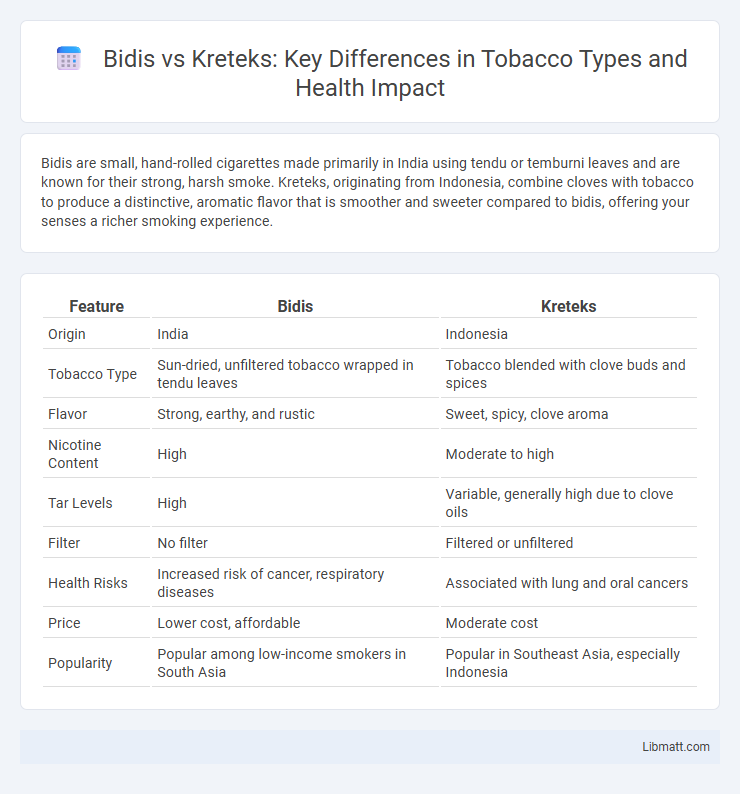Bidis are small, hand-rolled cigarettes made primarily in India using tendu or temburni leaves and are known for their strong, harsh smoke. Kreteks, originating from Indonesia, combine cloves with tobacco to produce a distinctive, aromatic flavor that is smoother and sweeter compared to bidis, offering your senses a richer smoking experience.
Table of Comparison
| Feature | Bidis | Kreteks |
|---|---|---|
| Origin | India | Indonesia |
| Tobacco Type | Sun-dried, unfiltered tobacco wrapped in tendu leaves | Tobacco blended with clove buds and spices |
| Flavor | Strong, earthy, and rustic | Sweet, spicy, clove aroma |
| Nicotine Content | High | Moderate to high |
| Tar Levels | High | Variable, generally high due to clove oils |
| Filter | No filter | Filtered or unfiltered |
| Health Risks | Increased risk of cancer, respiratory diseases | Associated with lung and oral cancers |
| Price | Lower cost, affordable | Moderate cost |
| Popularity | Popular among low-income smokers in South Asia | Popular in Southeast Asia, especially Indonesia |
Introduction to Bidis and Kreteks
Bidis are thin, hand-rolled cigarettes made primarily from tobacco flakes wrapped in a tendu or temburni leaf, commonly smoked in India and Southeast Asia. Kreteks, originating from Indonesia, are clove-flavored cigarettes combining tobacco, clove spice, and other additives, known for their distinctive aroma and mild anesthetic effect. Both bidis and kreteks offer culturally unique smoking experiences, differing significantly in flavor profile, production method, and regional popularity.
Historical Origins of Bidis and Kreteks
Bidis originated in India in the 17th century as hand-rolled tobacco wrapped in tendu leaves, traditionally used by rural populations. Kreteks, developed in Indonesia in the late 19th century, combine cloves and tobacco, creating a unique flavored cigarette favored for its aromatic quality. Both products reflect distinct cultural and regional histories, influencing their widespread use in South Asia and Southeast Asia respectively.
Composition and Ingredients
Bidis are hand-rolled cigarettes made from tendu or temburni leaves filled with shredded tobacco, often containing fewer chemicals and additives compared to kreteks. Kreteks, originating from Indonesia, combine tobacco with cloves and other spices, which contribute to their distinctive aroma and flavor, while introducing eugenol that can provide a numbing effect. Your choice between bidis and kreteks determines the type of smoke and potential health impacts due to their unique compositions and ingredients.
Manufacturing Processes
Bidis are hand-rolled cigarettes made by wrapping sun-dried, flaked tobacco in a tendu or temburni leaf, securing them with a thread, which results in a simpler, low-cost manufacturing process. Kreteks involve a more complex production method that combines ground cloves with tobacco, often mixed with other flavorings, and are machine-rolled or handmade, requiring precise blending to achieve their distinct aroma and taste. The manufacturing of kreteks demands specialized equipment and quality control to balance the clove content, whereas bidis rely on traditional artisanal techniques and minimal processing.
Cultural Significance and Popularity
Bidis hold deep cultural significance in South Asia, especially India, where they are traditionally hand-rolled and associated with rural communities and local artisans. Kreteks, originating from Indonesia, blend clove and tobacco and are celebrated for their unique aroma and medicinal properties, reflecting Indonesian heritage and rituals. Your choice between bidis and kreteks can reveal an appreciation for distinct cultural histories and regional preferences in smoking traditions.
Health Risks and Concerns
Bidis contain higher levels of nicotine, tar, and carbon monoxide compared to conventional cigarettes, leading to increased risks of lung cancer, respiratory diseases, and cardiovascular conditions. Kreteks, which contain clove and eugenol, pose additional hazards such as impaired lung function and potential allergic reactions, alongside the typical tobacco-related health issues. Both bidis and kreteks contribute significantly to the burden of tobacco-related morbidity and mortality worldwide.
Legislative Regulations Worldwide
Legislative regulations worldwide vary significantly between bidis and kreteks, with many countries imposing stricter controls on kreteks due to their clove content and associated health risks. Several nations have banned or heavily restricted kretek imports and sales under tobacco control laws, while bidis often face regulatory challenges related to their low cost and popularity among younger demographics. International health organizations continue to advocate for harmonized enforcement of tobacco regulations to limit the public health impact of both bidis and kreteks.
Market Trends and Consumer Preferences
The market for bidis and kreteks shows distinct regional preferences, with bidis predominantly favored in South Asian countries like India due to their affordability and traditional appeal. Kreteks, known for their clove flavor and smoother smoking experience, maintain strong popularity in Indonesia and are gaining traction in global markets driven by niche consumer interest in flavored tobacco products. Recent trends indicate a growing demand for kreteks in specialty tobacco segments, while bidis continue to hold market share in lower-cost, high-volume sectors.
Environmental Impact
Bidis are hand-rolled cigarettes made from tendu leaves and typically produce higher levels of carbon monoxide and particulate matter compared to kreteks, which are clove-flavored cigarettes blended with tobacco and cloves. Kreteks release more toxic chemicals due to the combustion of cloves and additional ingredients, contributing significantly to air pollution and environmental harm. Understanding the environmental impact of these tobacco products can help you make more informed choices regarding their ecological footprint.
Conclusion: Comparing Bidis and Kreteks
Bidis and kreteks differ significantly in composition, with bidis made from rolled tobacco leaves and kreteks containing a mix of tobacco and cloves. Both products carry substantial health risks, but kreteks release additional harmful compounds from clove combustion. Your choice between bidis and kreteks should consider these differences in chemical exposure and the associated impact on respiratory and cardiovascular health.
bidis vs kreteks Infographic

 libmatt.com
libmatt.com